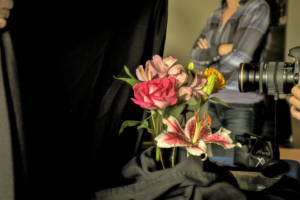A disposable film camera is fast and affordable for capturing memories. It is ideal for family outings, vacations, and outdoor activities because of its compact shape. The most significant advantage of disposable cameras is that even if they are dropped, the photos do not get affected. In addition, they are easy to handle for pro and amateur photographers. So let’s get started with the nuances of disposable film!

Digital cameras and smartphones have taken the tables of photography lovers with advanced features. Still, disposable cameras are returning due to a resurgent interest in film photography and their sturdiness, compact size, waterproof features, lack of rechargeable battery, and reduced price. As a result, several companies rush to produce these cost-effective disposable cameras.
Disposable cameras have been around since the 1980s. Kodak initially launched them as a substitute while on vacation or traveling abroad to process the camera film quickly. We will discuss this in detail further.
However, with digital film cameras widespread in all markets, most consumers are unaware of the disposable film camera’s existence – let alone utilize them. Disposable cameras are not entirely ‘disposable.’ The term distinguishes them from a standard, single-use camera.
How To Use a Disposable camera | tips for beginners in film
What Exactly Is A Disposable Camera?
Disposable cameras (also called single or one-time-use cameras) are compact, simple cameras that come loaded with either color or black-and-white film. They have no focal or exposure adjustments other than a built-in flash and are intended to be used by the photographer only once. After taking 24 – 27 photographs, the cameras are sent for processing, and the negatives are returned with copies or digital downloads of the images. They have an image sensor and a battery to power the flash (if they have one).

The materials used to construct these cameras are cheap and the images they generate are brilliant, high-contrast, saturated colors, and primarily sharp.
The term “disposable” refers to cameras made of simple materials such as plastic, paper, cardboard, and steel to reduce costs and avoid returning the camera to the photographer after handling it. As they are designed to be discarded by the photographer, they are more appropriately referred to as Single-Use or One-Time Use cameras.
Reusable cameras are accessible that come packed with film or can be refilled by the user to be used repeatedly. For example, the Ilford Sprite 35-II is for individuals who desire a more sustainable camera but still want the distinctive disposable or single-use camera feel to their photographs.
Kodak Vs Fuji Disposable Camera Challenge
Why Should You Use a Disposable Camera?
Shooting with a disposable camera is enjoyable and beneficial to the environment. A disposable film camera is affordable and allows you to travel light without carrying multiple lenses. This makes them ideal for family trips, holidays, or outings where pricey equipment would be difficult to maintain.

This style of the reusable camera also makes an excellent party favor! They make recording memories at any age-appropriate social occasion simple enough for everyone (from children to adults) to use. With its simple interface and built-in flash – aim and click!
Furthermore, disposable cameras are much more long-lasting than they were in the past. They’re frequently accessible in great-value multipacks, which is perfect if you wish to add them as a fun thing at a ceremony or party.
They are user-friendly, so young children and self-proclaimed technophobes may enjoy them. Finally, you’ll receive a collection of actual prints that you’ll be able to enjoy for years.
Why Are Disposable Cameras Reemerging?
Despite the clarity and comfort of intelligent devices, disposable or single-use cameras are regaining popularity. There are various factors influencing the resurgence of disposable film cameras.

- The absence of a filter indicates that the photograph is genuine.
- You get what you get because there is no preview or delete option.
- Due to the limited number of exposures, you must carefully select your images.
- When you receive your prints or digital scans, the surprise factor adds to the enjoyment of seeing your photos.
- Printed photographs can be shared in forms that digital pictures cannot.
We frequently discover that the old ways work best, which is particularly true in the instance of disposable or one-time-use cameras. People flock back to cheap disposable cameras to capture their memories because the bright, grainy photo evokes simpler times when we all felt the need to film every meal and moment. However, because of the scarcity of images accessible to us, the scenarios we pick to use our restricted number of shots (usually about 24 – 27) using single-use cameras have a higher relevance.
With a disposable or single-use camera, we capture the authenticity of a realistic moment as it occurs. Simply, it is what it is. The fragility of those moments lures us back to adopting disposable film cameras after nearly two decades of displaying nicely polished photographs to the world. Finally, we can return to being ourselves without thinking about obtaining the perfect shot and enjoying every moment.
Why Are Disposable Cameras Made?
Disposable cameras were created for the standard population who wanted to capture memories without going through a laborious process or worrying about breaking or losing their expensive camera. Disposable cameras integrate the most outstanding features of cameras into a small, relatively unbreakable package, and they are:
- Simple to Use
- Inexpensive
- Sturdy
- Lightweight and compact
- The absence of a rechargeable battery
- Waterproof
- Simple development procedure
Nature enthusiasts would bring these cameras on a trip or mountain trek. They have no batteries to recharge, can be impermeable, are small enough to fit in your pocket, and are unaffected by the knocks and falls of the route.
HOW TO UNLOAD FILM FROM A DISPOSABLE CAMERA // FUJIFILM
The History of the Disposable Camera
Disposable cameras predate our current digital cameras by more than a century, with the earliest specimen dating to the late nineteenth century. This device cost 25 cents and was made of a glass plate, paper, and cardboard- a price much lower than the average 1880s handheld’s cost of $50. If this appears to be an acceptable camera price today, remember that in the 1880s, $50 was around the present equivalent of almost $1000, making the portable a premium item most people couldn’t buy.
One of the primary motivators for developing disposable or single-use cameras is affordability. People wanted an inexpensive device that let them preserve their most important moments, but they also didn’t care much about the device itself. Their primary interest was in its images, not in the camera itself. As a result, firms worked hard to produce a low-cost, user-friendly device you can throw away after usage.

Another critical consideration was portability. The early portable cameras had a significant disadvantage because they were bulky hardware requiring numerous components to function. Not to mention a stable seat, which suggested users had to bring long wooden tripods on their trips if they wanted to shoot the event. Ultimately, the procedure was more work than worthwhile, so these extravagances were usually left at home. As a result, disposable cameras were created using low-cost, lightweight materials.
The Photo-Pac, the ultimate generation of these gadgets, was introduced in 1949. This smart disposable camera allowed consumers to take eight 35mm film exposures for $1.29. The users did not have to do anything to create the photos once they were born. They just mailed their camera to the company, which developed the images and returned them to the buyer. A simple procedure that anyone might use.
Despite its excellent design and business approach, the Photo-Pac was not widely adopted at the time. The disposable camera didn’t fully take off until Fujifilm’s model, the Utsurun-Desu, was created in 1986.
Disposable film cameras were so successful that current photography industry behemoths such as Kodak, Nikon, and Canon decided to give it a shot. New models were released and improved competitively until, by 2005, the disposable camera had become a public mainstay for economical and easy picture-taking.

What Are the Functions of Disposable Film Cameras?
Disposable film cameras function similarly to primary point-and-shoot cameras; the main distinctions between these and other cameras are the substances used in their manufacture, the limited settings, and the planned number of users. In addition, Digital and other film cameras are designed to last for years with reasonable care. In contrast, disposable cameras are intended to be discarded after processing or recycled to be loaded with fresh film and resale.
Disposable cameras use a plastic, fixed-focus lens and either 35mm film or an APS cartridge sold exclusively or loaded inside the camera. Most cameras provide for 27 exposures. Some cameras may include extra features such as more exposure levels, the film in the device, flash, filters, and durability, depending on the product.
The camera film is held inside the camera’s container on a spindle and is wound by a winding gear. When you want to take a photo, roll your finger over the spiral gear, usually positioned in the top right corner of the camera’s rear.

When you hear the click that indicates the film is prepared for the first (or next) image, or when it no longer advances, look down the viewfinder from the back of the device and press the top-right button. If the flash is turned on, pressing this button will enable it and expose the camera’s shutter for a brief period (usually 1/80th of a second), allowing light to enter through the sensor and take your picture on the camera’s film.
Due to their fundamental components and structure, disposable film cameras do not have many alterable settings. They will not change depending on light exposure or lack of light apart from turning on or off the flash. As a result, users must exercise extreme caution when taking photographs and evaluating their surroundings when utilizing their limited film supply.
Types of Disposable Cameras
Various disposable cameras are accessible and you can experiment with your photography skills. Also, numerous choices are available for simple color disposable cameras.
Specialized disposable cameras are available, such as waterproof ones intended to be used in or near water. They are constructed similarly to a standard disposable camera, except they lack a flash and are enclosed in a waterproof plastic casing. Waterproof disposable cameras are ideal for a day at the beach, diving, sailing, and general use near water. However, it is vital to remember that these disposable cameras do not have a flash and should only be carried 5 meters below the water surface for optimal results.
It might also be fun to consider utilizing a black-and-white disposable film camera to capture your recollections in a sentimental photography style.
Best Disposable Film Cameras
The best 35mm and waterproof disposable cameras and where to get them are listed below:
| Camera | Color or B&W Film | Exposures |
| Kodak Fun Saver | Color Film (ISO 400) | 27 |
| Fujifilm Quicksnap | Color Film (ISO 400) | 27 |
| Lomography Simple Use (reloadable) | Black and White (ISO 400) | 24-36 |
| Kodak SUC Daylight Disposable Analog Camera | Color Film (ISO 800) | 39 |
| Kodak Waterproof Water & Sport | Color Film (ISO 400) | 27 |
| AgfaPhoto LeBox Ocean 400 (waterproof) | Color Film (ISO 400) | 27 |
| Ilford XP-2 Super 400 135-36 Black & White Film | Black and White (ISO 400) | 27 |
| Kodak Professional Tri-X 400 | Black and White (ISO 400) | 27 |
| Fujifilm Disposable QuickSnap Waterproof | Color film (ISO 800) | 27 |









Tips for Taking Better Pictures with a Disposable Camera
A disposable film camera is easy to use and flexible. However, not having all your images turned out might be perplexing and irritating. These tips and tactics will assist you in taking better pictures with your disposable film camera and achieving the ideal role of a digital camera.
Shoot in Natural Lighting
By simply opening the shutter, these cameras can improve low-light images. Shoot in strong sunlight for the best outcomes (preferably during the daytime).
Most disposable cameras include a flash. They can, however, overexpose photographs, and you won’t be able to recover them after pushing the shutter. There is no way to edit or delete a photograph once it has been taken. Digital formats are interchangeable. Controlling exposure is extremely limited. As a result, you should pay attention to the light. In low-light situations, a flash is an excellent tool for portrait photography.
Using natural light intelligently is the best method to capture fantastic images. With the sun behind you, make use of the shadows as the quality of light makes or breaks a shot.
Keep your hands stable
Although disposable cameras are relatively steady, you can avoid blurring by employing a shooting surface. Place your camera on a sturdy surface like a table or a post to help stabilize your hands while shooting. This is particularly true while shooting in low-light conditions.
Filters
You can use filters from other cameras. In addition, you can employ polar song glasses to achieve the desired effect. Turn the camera till the scene is ready. To charge the lights, click the flash button. Set your camera using the viewfinder, then hit the upper button. This feature is simple to use.
The Bottom Line
Disposable film cameras take up less space and require no additional attachments like tripods, table stands, converters, or extra batteries. However, several low-cost options are available if you prefer to conserve money and invest in digital alternatives.
A disposable camera is indeed a fantastic starting point for people who want to generate a little extra money from their photography hobby.
Videos on Disposable Film
One-Time Use Film Cameras! Overview and History (Audio)
Why Disposable Cameras Exist – Film Photography Talk
My Favorite Disposable Alternative; Lomography’s Simple Use Film Camera Review + How To Use & Reload
Disposable Camera Tips and Tricks












